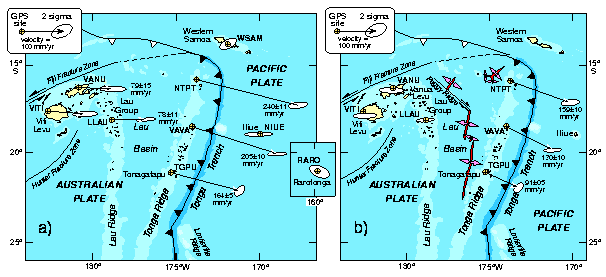Crustal motions in the Tonga-Lau Island Arc System
M. Bevis1, F. Taylor2 and B. Schutz2
1University of Hawaii; 2University of Texas at Austin
Bevis et al. [1995] recently published the first direct measurements of crustal motion near the Tonga trench, where the Pacific plate subducts
into the mantle underlying the Lau Basin. By comparing the relative position of a network of survey markers observed using GPS in 1990 and
1992 they determined the relative velocities of the earth's crust at these stations. Figure 1 depicts these velocities in a frame of reference in
which three stations (WSAM, NIUE, RARO) located in the Pacific plate are very nearly stationary. In this Pacific-fixed frame the three Fijian
stations (VITI, VANU, LLAU) are moving at about 80 mm/yr (bearing ~ N91oE) which reflects the relative motion of the Australian and Pacific
plates (Fiji is part of the Australian plate). In contrast the velocities of the three Tongan stations (TGPU, VAVA, NTPT) increase northwards from
164 - 240 mm/yr (bearing ~ N106oE), the fastest plate motions ever observed anywhere on earth. These very high subduction rates arise from a
combination of the Australian-Pacific plate convergence and the opening of the Lau Basin (back-arc spreading). This second component can be
isolated by performing a plate circuit, and by viewing the velocities of the Tongan stations relative to the Australian plate (Figure 2).
The velocities in this frame increase northwards from 91 - 159 mm/yr. Interestingly this rate of opening is significantly higher than has
been proposed on the basis of magnetic lineations within the basin. There is no evidence of longitudinal strain within the Tonga arc, suggesting
that it acts like a rigid windshield wiper as it rotates to accommodate widening of the Lau Basin. The subducting portion of the Pacific plate in
this region is the most active zone of mantle seismicity anywhere on earth. It has not been clear why this slab generates so many more
earthquakes than other subducting slabs worldwide. The new GPS results suggest that this intense seismic activity is a consequence
of very rapid subduction of the Pacific plate at the Tonga trench.

Figure a. GPS station velocities (1990 - 1992) relative to the Pacific plate. Figure b. GPS station velocities (1990 - 1992) relative to the Australian plate.
